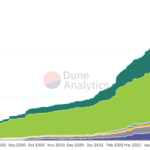Maybe you should now hoard stablecoins instead? Let’s look at it.
One of the things that changed in the last year is the perception of work. In addition to job security becoming questionable for many around the world, the majority of the workforce had to go through a rapid adaptation to fully digital and, in many cases, remote work.
Nevertheless, this situation has opened the door to more and more international teams working with more mature processes. Something that is not necessarily easy for employers either. A new reality has risen for them too as following some surveys, 1 in 2 people won’t return to jobs that don’t offer remote work.
Yet, even in these circumstances, there are sectors of the economy (such as stablecoin exchange) showing strength and even arousing the interest of some leaders to attract investment.
One of the behaviors that we have seen on the rise in a short time is the remote economy. We have learned overnight to use remote services that used to be local and pay for them with digital money.
Needless to say, the pandemic hit the sectors that were already undergoing complex transformations. Car manufacturing, for instance, was transitioning to more sustainable sources of energy. The banking sector, for its part, was immersed in its own journey through the desert, trying to accept, adapt or recycle itself to face new challenges such as the new digital economy led by decentralized finance (lead by stablecoins DeFi).
The challenge can be visualized in the numbers of this new exploding sector of the economy, surpassing the $100-billion-mark. New financial services (crypto wallet, DeFi crypto exchanges, Crypto Staking) and new names (Eidoo, Uniswap, USDC…) are becoming very common for many.
Source: Coingecko report Q1-2021
The popularization of DeFi was always held back by the volatility of the financial assets it handled. This, in turn, prevented many conservative investors to start managing sensitive assets such as the salary we receive and with which we pay our needs and small pleasures in crypto.
What Is a Stablecoin?
The need for price stability resulted in a new type of coin that would keep the peg to the price of a fiat currency. These are cryptocurrencies erc20 tokens, whose main advantage is maintaining parity with a fiat currency, that is, the money we use daily to buy bread or streaming TV. You can find them having different fiat of reference, although the most popular are those that maintain parity with the USD.
How good different stablecoins peg to the USD. The steeper, the better.
Source: The Stablecoin index, Messari.io
The ability to peg to a price makes them the ideal medium to go beyond the crypto environment and be used for other uses such as international payments, obliviating the need to have accounts in several countries.
It is also worth noting that one of the most attractive advantages for millions of people is precisely the ease of access to a reliable currency such as the USD. Getting access to a trustable means of converting your savings to USD has been a constant preoccupation for businesses and households alike. However, stablecoins’ price offers protection against uncontrolled inflation in some countries with weaker currencies or unstable economies.
Therefore, their growth has understandably been impressive. The daily usage of this type of cryptos has taken off during the last several months in response to the fluctuations fiat currencies have been experiencing and their value debasement. Also, as the price is essentially constant, the market cap (total market capitalization) has grown accordingly.
Source: Dune analytics
Stablecoins are a tool that enhances the capabilities of fiat money by being in between the two worlds — the crypto world and your trusted baker.
On the one hand, they achieve price stability through a reserve system equivalent to the reserve for fiat currencies themselves. In some cases, this reserve is made in the reference currency (usually USD) partly or entirely with a balanced set of other cryptocurrencies. In any case, the goal is always to maintain price parity.
On the other hand, stablecoins have an arbitrage system that encourages arbitrageurs to participate when the price deviates from the target parity.
This idea of purely digital money is so attractive that the central banking authorities of many countries themselves have followed suit by putting on the table plans to launch their own versions of electronic currencies, the so-called CBDC (Central Bank Digital Currency). Its aim, however, is more to become a tool for the financial system than an aid to the daily life of the ordinary citizen.
Why You Need Stablecoins?
As stated before, the use of this type of crypto assets has been increased in the past year, in response to the destabilization of the traditional financial system. This includes people getting their pay in cryptocurrency just as public Institutions are willing to get the taxes paid with them. We already saw such cases in Switzerland or Miami, where the major went event further offering to pay municipal employees in Bitcoin.
This type of cryptocurrency can be used through a debit crypto card. The way it works for the outside world is the same as with cards in dollars, euros, or rupees. It is a card linked to an account, and when you pay for something, the price is deducted from your erc20 wallet.
Moreover, you can have a card linked to a crypto account. If the account is denominated in stablecoins, you don’t have to worry about market price movements as its value is stable. Some companies have even partnered with big credit card brands, and you can use their cards in ATMs. That takes all the geekiness out of it, though, doesn’t it?
A perfect example of this is eidooCARD. Eidoo is already offering a VISA debit crypto card for online and offline purchases, as well as ATM withdrawals.
In addition, many sites don’t even require you to pay in fiat, and the stable cryptos themselves serve as a payment method. This is the case of the more than 1000 stores that list websites.
By solving the problem of volatility and usage as a mainstream currency, stablecoins address the major difficulties in achieving mass adoption. However, the crypto world can be a barrier in itself because of the novelty of the idea. In this sense, not all platforms are equal. Some help the user more than others not to get lost in the maze of tokens out there and avoid suffering a syncope overwhelmed by the sometimes cryptic crypto jargon.
















